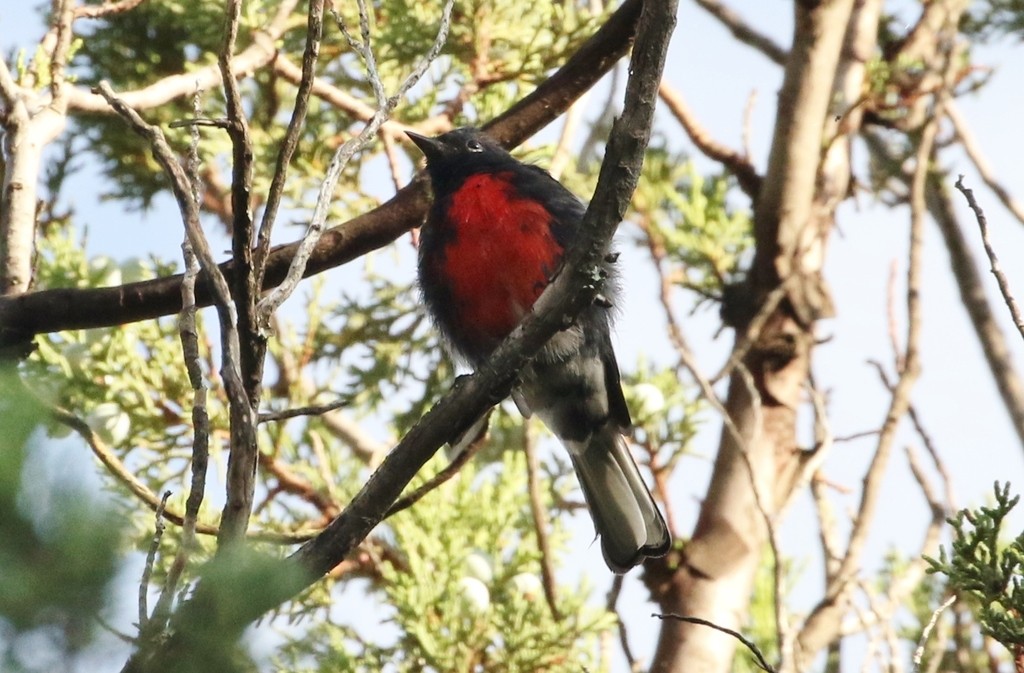Painted Redstart
A species of Whitestarts Scientific name : Myioborus pictus Genus : Whitestarts
Painted Redstart, A species of Whitestarts
Botanical name: Myioborus pictus
Genus: Whitestarts
Content
Description General Info
 Photo By silversea_starsong , used under CC-BY-NC-4.0 /Cropped and compressed from original
Photo By silversea_starsong , used under CC-BY-NC-4.0 /Cropped and compressed from original Description
The painted whitestart is the largest of the whitestarts. Measurements: Length: 5.1-5.9 in (13-15 cm) Weight: 0.3-0.4 oz (8-11 g) Wingspan: 8.3 in (21 cm) The sexes are the same in plumage, though males average slightly larger than females. The adult is mostly black, with a bright red lower breast and belly, large white wing patches, white outer tail feathers and white crescents below its eyes. The bill and legs are blackish. The juvenile painted whitestart lacks the red belly and glossy black plumage of the adult. It is brownish-gray overall, with a paler belly and undertail coverts, and a pale cream or buff tinge to its wing patches. 
Size
14 cm (5.5 in)
Life Expectancy
7 years
Nest Placement
Ground
Clutch Size
3 - 7 eggs
Feeding Habits
Painted Redstart predominantly consume insects, employing tactics such as branch-hopping, body-pivoting, tail-fanning, and wing-flashing to dislodge and catch prey. They glean or hover-glean insects off foliage and may capture them mid-flight or from water surfaces. In spring, they supplement their insectivorous diet with tree sap and occasionally feed on suet or sugar water at feeders.
Habitat
Painted Redstart primarily inhabits montane forests between 1,500–2,500 meters in elevation, favoring open oak woodlands and riparian canyons. This species thrives in diverse vegetation such as oak, pine-oak, and juniper, with a preference for dense, shady forests and undergrowth near permanent water during breeding. In winter, their habitat extends to similar regions in Mexico and Central America.
Nest Behavior
Painted Redstart typically nests on the ground, rarely in trees. Construction sites are well-covered, such as cavities or under shrubbery. Nest construction and egg-laying are seasonal, with parents providing attentive care for eggs and offspring.
Nest Characteristics
Painted Redstart's nest is a substantial cup or oval-shaped bowl, averaging 4 inches across and 2.6 inches tall, with a 2-inch wide and 1.3-inch deep interior. Located on slopes or in cavities, under bushes, the nest is made from grass, pine needles, leaves, and lined with fine grasses and hair, often featuring an oak leaf pathway on the downslope side.
Dite type
Insectivorous
General Info
Feeding Habits
Bird food type
Bird Feeder Type

Platform
Sounds
Call
Recording location: Mexico
Song
Recording location: Mexico
Behavior
Painted Redstart exhibit distinct mating rituals; males perform courtship displays by fanning their tails and singing, both on the ground and in aerial acrobatics. These vivid displays can involve paired singing with responsive females. Their rich, melodic vocalizations, sometimes subdued to a 'whisper' song, extend into the nesting period. Painted Redstart are not solely dedicated to elaborate courtship; both partners are actively engaged in nest-site selection, with females taking the lead in choosing and constructing the nest. Post-construction, painted Redstart collaboratively share the responsibilities of incubation and chick-rearing, maintaining close proximity throughout the breeding cycle.
Distribution Area
Painted whitestarts are common in open oak woodlands and canyons at heights between 1,500–2,500 m (4,900–8,200 ft) in Central America and Mexico, ranging as far north as the Madrean sky islands and Mogollon Rim in Arizona and New Mexico and Big Bend National Park in Texas. During the summer and winter, these birds may venture as far south as Nicaragua. In 2010, a painted redstart was found further north in California than had ever been recorded, in Auburn, CA, east of Sacramento. In 2013, one was observed in Berkeley, CA. 
Species Status
Not globally threatened.
Scientific Classification
Phylum
Chordates Class
Birds Order
Perching birds Family
New world warblers Genus
Whitestarts Species
Painted Redstart